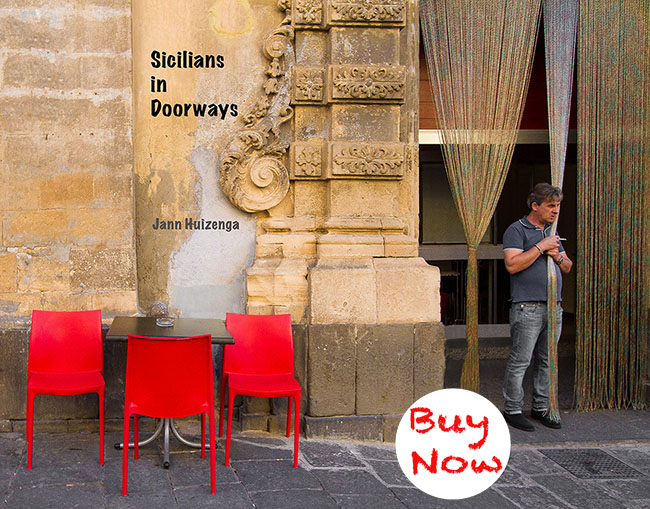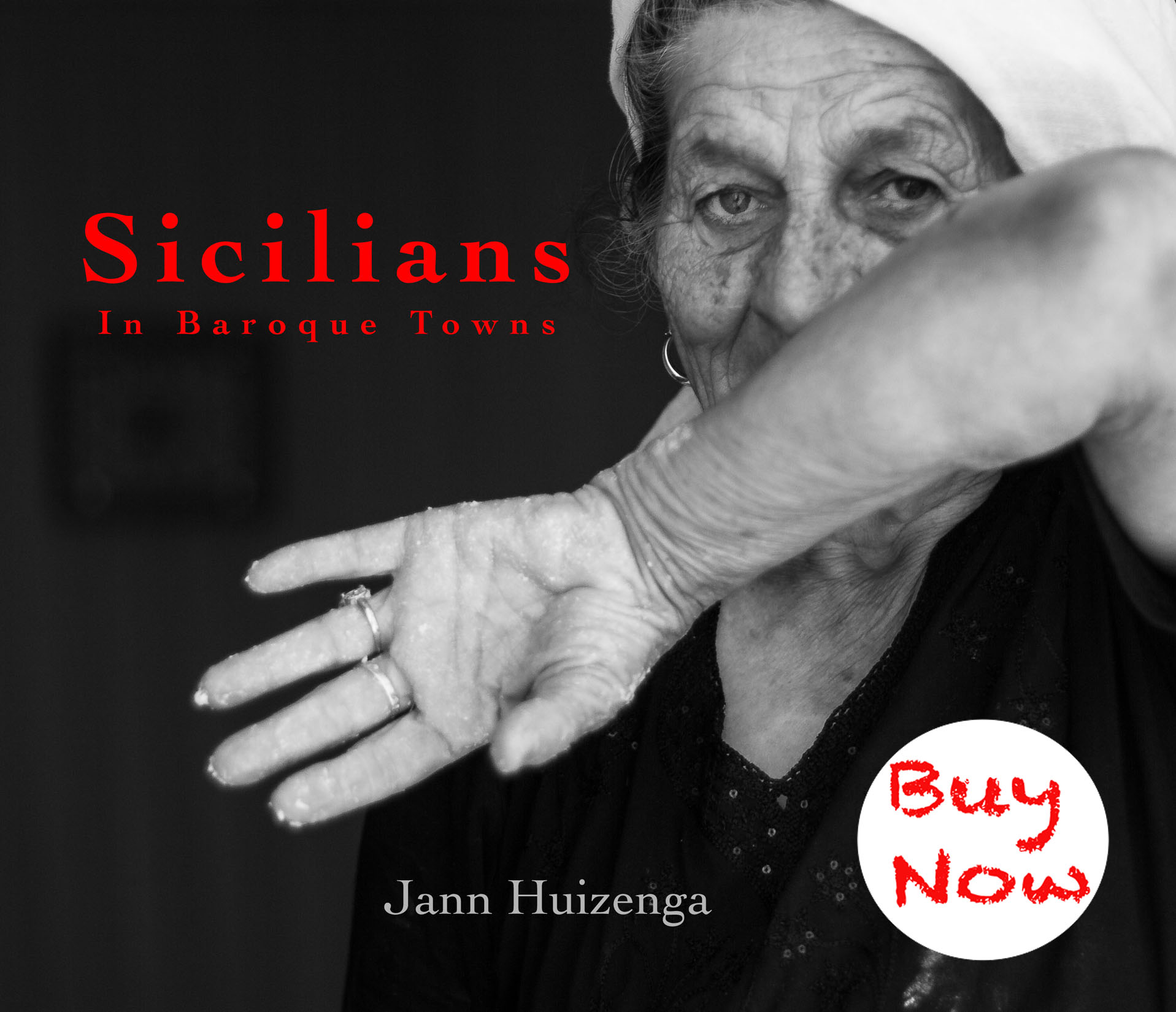May 6, 2010
My kitchen sink arrived from Tuscany in a beat-up truck with a blue plastic curtain. The truck came to a halt in front of the house. A burly driver got out and slowly slid open the curtain to unveil the sink as if were an opera d’arte.
Which, in a way, it is.

Having walked into my renovation blind as a bat, I’ve been, generally speaking, a catastrofista. But not this time. The sink is perfect. It’s made of graniglia—whatever that is—and is supple as silk. I run my hands over it the way you’d stroke a cat.
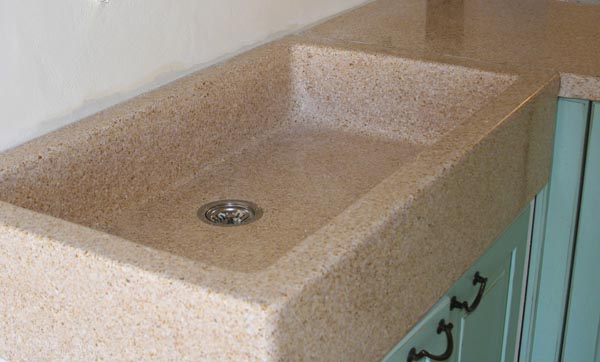
It awaits a backsplash of colorful Caltagirone tiles.
I no longer need to bathe from two old buckets or stoop over an old shower drain to brush my teeth. I have a sink!
I’ll be washing dishes in this sink soon. That’s right: No dishwasher.
My life in Sicily is all about getting into the rhythms of a slow island life, stepping back into another century, learning to dawdle. Less is more is my new mantra. This does not mean that I’ll give up my computer and subsist on snails and wild chickory, but it does mean I’ll forgo a dishwasher. A dryer, a freezer, a car. Even a TV. I’ll start savoring the way stars light the night. The way vines drip with grapes. The way doves strut and coo on bleached terracotta roofs.
***
Click to comment.
Click to subscribe.
***
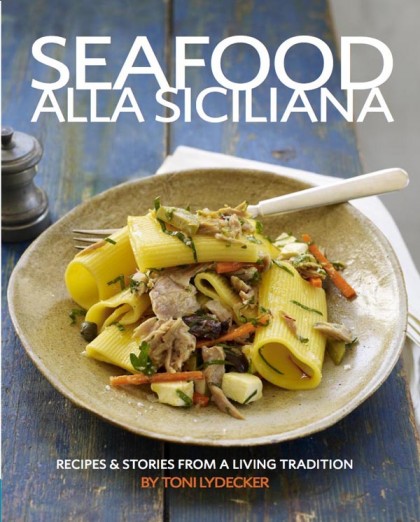
You can win this cookbook!
Toni Lydecker’s Seafood alla Siciliana is somewhat smaller than coffee-table size, with thick, glossy paper, wonderful recipes, very pretty photos, and stories about Sicily’s cuisine. All you have to do is leave a comment on any of my blog posts between now and May 9, and I’ll enter your name for a random drawing on May 10, 2010. (You can enter one comment a day, max.) The only hitch is that you must provide a US or Canadian address for the shipping, so my apologies to readers on other continents.
April 26, 2010
Tragedy in the bathroom.
Remember those beastly expensive Italian glass tiles I naively ordered?
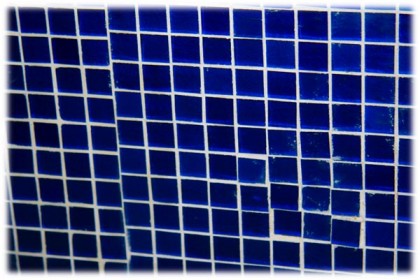
These are them, installed.
When I sprayed glass cleaner over my new sea-blue walls, wiping away the obscuring film of white plaster the mason had left, I could not believe my eyes. Not a single straight line! As if an ill-tempered four-year old had been hard at work.
How could I have allowed this to happen, you ask?
Well, early in the day, curiosity kept prompting me to run down two flights of stairs and check on the work. After 30 minutes of this, the mason said I made him nervous, and would I please go away and cease to bother him? The work is molto delicato, he said, and it is necessario to concentrate and be left solo.
And so away I went, full of cockeyed hope that I’d soon have a useable bathroom.
I returned to the house after two days, descended into the winery-cum-guest quarters and beheld anarchia. Thousands of tiny mosaic tiles stuck willy-nilly onto the wall. I felt like I’d been gored.
But I refused to face reality. Don’t panic, I told myself. It’s rustic. Rustic is good. It fits the theme of the wine cantina. Molto rustico! Charming in its own way. Isn’t it? Isn’t it?????
I called over a few friends to have a look. Horrid, they said, daring to utter the bald truth. Really horrid.
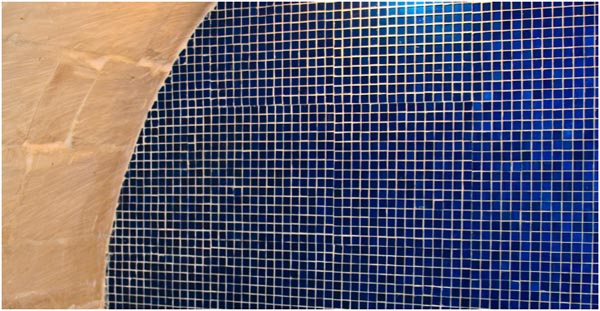
It doesn’t look bad from afar, though, does it? If you kind of … squint at it?
Now what do I do.
***
Click to leave a comment.
Click to subscribe.
April 12, 2010
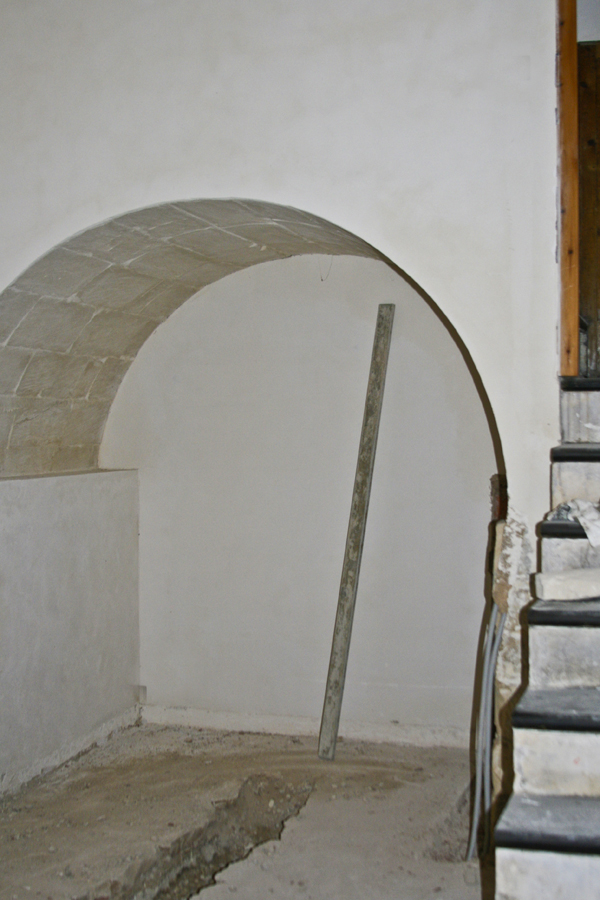
…
Into the cramped space under this arch—hardly big enough for a closet—I plan to stuff an entire bathroom: sink, toilet, shower, heat rack, mirror, towel racks. The project manager is insisting on a bidet (he says no Italian can live without one), but you’d have to put your foot in the bidet to squeeze into the shower.
This is part of the cantina, the old wine cellar that is slowly morphing into guest quarters.
I plan to expose as much stone as possible inside and above the arch. The back wall, which needs to be waterproof, will be a sea of tiny tiles. Tiles the blue of a storm-tossed Ionian Sea.
Beastly expensive tiles.
I knew nothing about the cost when I ordered. I didn’t bother to ask the price. I figured: they’re just tiles made right here in Italy, not some expensive import. How much could a few little tiles cost?
The boxes finally arrived from Milan, along with the bill. My eyes popped. I had to read it over and over. I could feel my face on fire.
“Well, you ordered glass tiles,” the project manager says. What did you expect?”
I did notice how lustrous they were, but I had no idea they were glass.
I thumb through the instruction manual that comes with the tiles. The installation looks complicated. “Are you sure the mason is up to this?” I ask the project manager. The mason seems to have perfected the art of banging and pounding, but I’ve never seen him do anything delicate with his thick, calloused hands. Do I trust him with my treasures? Has he ever installed anything of the sort?
“Non preoccuparti,” says the project manager, winking. Don’t worry.
This is the favorite phrase down here. It usually means trouble.
But who am I to argue?
***
..
Click to comment.
Click to subscribe.
April 8, 2010
The men in my town are good at sitting around.
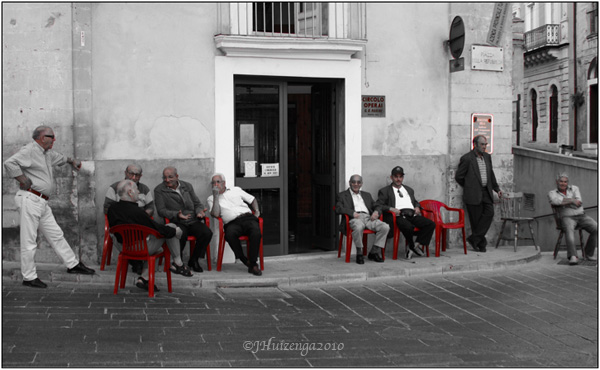
I like this; it makes the streets feel homey.
Retired guys gather at circoli, men’s clubs, like the above circolo for operai (workers) in Ragusa Ibla.
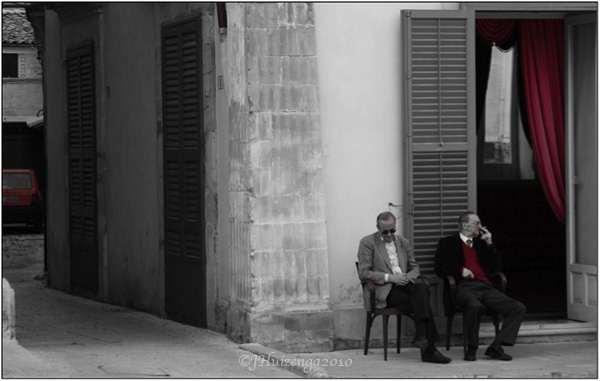
The Circolo di Conversazione for noblemen is on Piazza Duomo. Note the heavy brocade drapes and the fact that the aristocrats lounge on wooden chairs instead of plastic ones. Inside swing old cut-glass chandeliers.
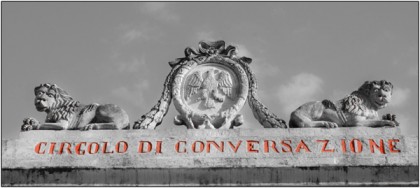
The Circolo di Conversazione is across the street from the fishermen’s club. Someone told me the two groups never mingle or even exchange a buon giorno, but I’m not sure if that’s true.
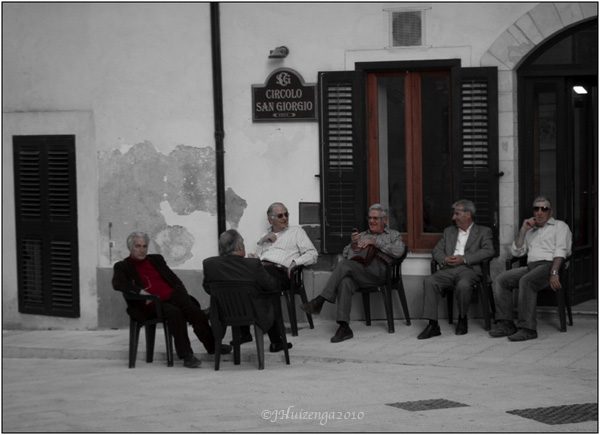
Tourist tip for women in Sicily: don’t let the fixed stares of sitting-around Sicilian elders put you off. They’re curious, bored, sweet as pie. I started a conversation with these members of Circolo San Giorgio—yet another club in Ragusa Ibla—and the men responded with Old World courtesy, eager to use their schoolboy English to discuss New Jersey cousins, American politics, and World War II, when the Allies charged through the area during Operation Husky. They even invited me inside!

I wonder what the wives are doing while the husbands are sitting around.
***
Click to leave a comment.
Click to subscribe.
March 30, 2010
Surprise! The 20th-century layers have been chipped off my walls, and I think we’ve found—in addition to big old blocks of Norman stone—some traces of Arab architecture.
North African Moors ruled Sicily for only a couple of centuries more than a millennium ago, but their influence on the island was, and is, huge.
Before I show you my little discovery, take a good look, if you will, at these keyhole-shaped doorways in North Africa.
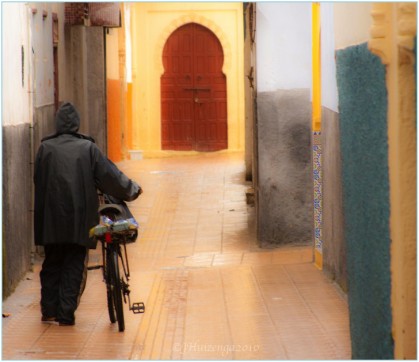
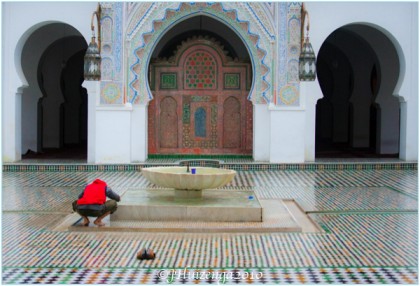
OK, now compare those doorways with the one below in my house. The arch shape turned up when we pulled off the modern wooden door frame. Don’t you think it looks vaguely Moorish in design?
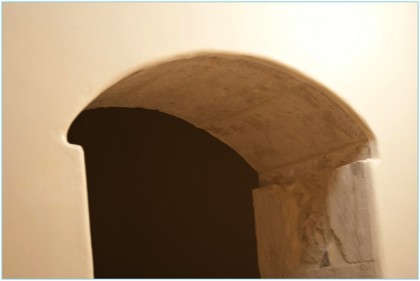 It’s not as beautiful as those North African doors, I know, and the curved thingamajig is way up top rather than in the middle of the arch, but still … it makes me wonder. It’s certainly not a pure Roman or Greek arch (more on that below). It’s not as beautiful as those North African doors, I know, and the curved thingamajig is way up top rather than in the middle of the arch, but still … it makes me wonder. It’s certainly not a pure Roman or Greek arch (more on that below).
I now have three of these vaguely Moorish arches on the top floor of my casa.
The house is a historical puzzle. The top floor, I’m quite sure, was built sometime soon after the 1693 earthquake that leveled not just Ragusa Ibla, but much of southeast Sicily. As I’ve mentioned earlier, the stone blocks in this doorway and elsewhere in the house were looted from the Norman castle that stood on this site and crumpled in that quake. (I know this only because neighbors have told me.)
So, assuming the above timeline, this means that 700 years after the Moors left Sicily, local Sicilian builders still carried traces of their Arab heritage in their builders’ DNA.
Everything here is so knotted and twisted together; it’s hard to tease out the many strands of history from all the superimposed cultures and styles. Layers upon layers—that’s what Sicily is all about.
The house becomes older the lower you go. The bottom floor used to be a cantina, a place where wine was made and stored (soon to be guest quarters). The arch down there seems Greco-Roman in style, an uninterrupted curve.
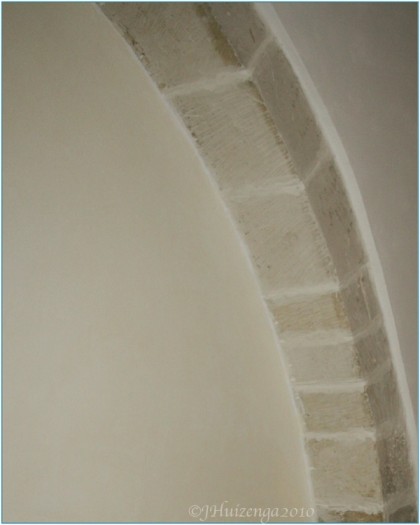
When was it constructed? Stay tuned. Maybe someday I’ll figure it out. Perhaps you have an insight?
***
For more on the Muslim rule of Sicily, click here.
***
Click to leave a comment.
Click to subscribe.
|
Subscribe to Baroque Sicily
Copyright reserved -
All photos and text on BaroqueSicily are Copyright of Jann Huizenga ©2009-2015, unless otherwise noted. Material may not be copied or re-published without written permission. All rights reserved.
|













 It’s not as beautiful as those North African doors, I know, and the curved thingamajig is way up top rather than in the middle of the arch, but still … it makes me wonder. It’s certainly not a pure Roman or Greek arch (more on that below).
It’s not as beautiful as those North African doors, I know, and the curved thingamajig is way up top rather than in the middle of the arch, but still … it makes me wonder. It’s certainly not a pure Roman or Greek arch (more on that below).
